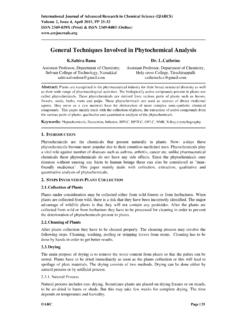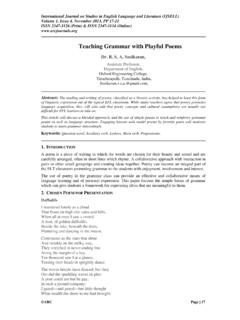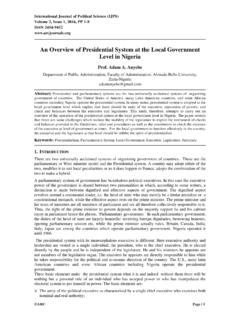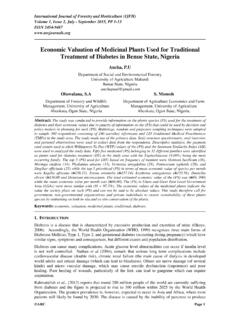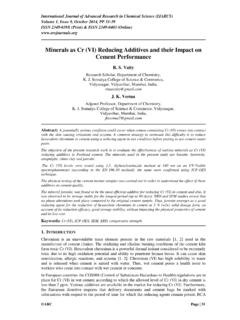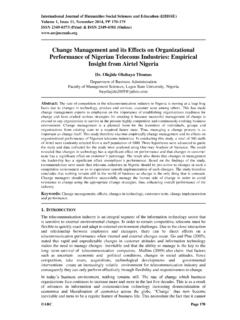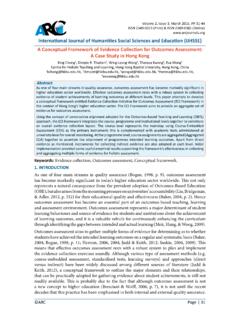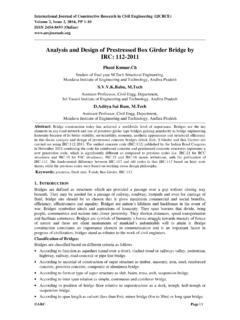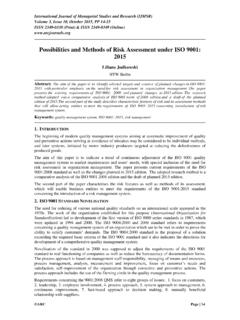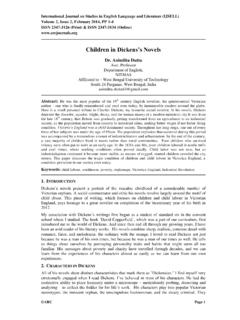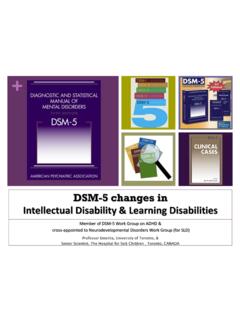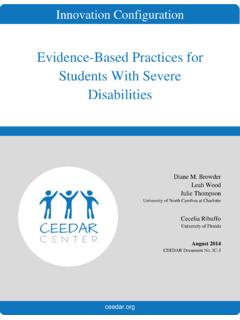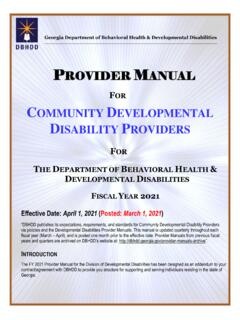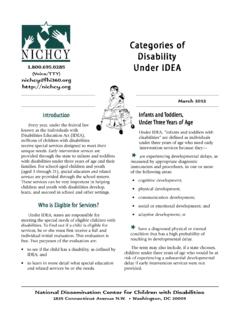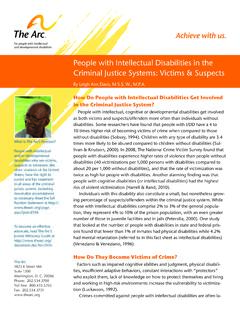Transcription of Learning Disabilities: Characteristics and Instructional ...
1 International Journal of Humanities Social Sciences and Education (IJHSSE) Volume 3, Issue 4, April 2016, PP 111-115 ISSN 2349-0373 (Print) & ISSN 2349-0381 (Online) ARC Page | 111 Learning disabilities : Characteristics and Instructional Approaches Mrs. Sana Ali Research Scholar,Education, Mewar University, Rajasthan India, Lecture, University of Dammam, Dr. Mohammed Rafi Head/Professor, Education, Al-Madina College of Education Mahboob Nagar District, Telangana,India Abs tract: A Learning disability is a neurological disorder. In simple terms, a Learning disability results from a difference in the way a person's brain is "wired." Children with Learning disabilities are smart as or smarter than their peers. But they may have difficulty reading, writing, spelling, reasoning and organizing information if left to figure things out by them or if taught in conventional ways.
2 A Learning disability can't be cured or fixed; it is a lifelong issue. With the right support and intervention, however, children with Learning disabilities can succeed in school and go on to successful, often distinguished careers later in life. Parents can help children with Learning disabilities achieve such success by encouraging their strengths, k nowing their weak nesses, understanding the educational system, work ing with professionals and Learning about strategies for dealing with specific Individuals with disabilities Education Act (IDEA), a federal law, defines a Learning disability as a condition when a child's achievement is substantially below what one might expect for that child. Learning disabilities do not include problems that are primarily the result of intellectual disabilities , emotional disturbance, or visual, hearing, emotional or intellectual disabilities .
3 Ke ywords : Learning Disability, Children, Reading, Right Support, Parents, IDEA 1. INTRODUCTION TO THE CONCEPT OF Learning DISABILITY The definitions given by various authors suggest that Learning disability refers to a retardation, disorder,or delayed development in any one or more of the processes of speech, language, reading, spelling, writing, or arithmetic. These problems are due to disorder or deficiency in any one or more of the basic psychological processes involved in understanding or in use of spoken or written language. They do not include Learning problems which are due primarily to visual,hearing or motor handicaps, mental retardation, and emotional disturbance or to adverse environmental child ,thus can be considered as Learning disabled if,(1)he has considerable difficulty in understanding or using spoken language,reading,writing,spelling,and arithmetic,during the developmental period (before 16 years of age),(ii) he has adequate facilities, interest and motivation to learn( Ramaa, 1992).
4 According to government regulations, students with Learning disabilities have disorders in one or more basic psychological processes involved in understanding or using language, spoken or written, which may manifest itself in an imperfect ability to listen, think, speak, read, write, spell or do mathematical calculations. There are many different kinds of Learning disabilities . Most often they fall into three broad categories: Reading disabilities (often referred to as dyslexia) Written language disabilities (often referred to as dysgraphia) Math disabilities (often called dyscalculia) Ge ne ral Characte ris tics of Learning Dis abled Stude nt The Learning disabled students exhibit certain general Characteristics features, the knowledge of which is essential in identifying them at the very early stage and understand the difficulties faced by such is given a list of the general Characteristics features of Learning disabled children.
5 (Ramaa, 1992) Mrs. Sana Ali & Dr. Mohamme d Rafi International Journal of Humanities Social Sciences and Education (IJHSSE) Page | 112 2. ABNORMAL ACTIVITY LEVEL Hype ractive: constantly engaged in some form of unnecessary motor to react to environmental changes or seems to do everything in slow motion. Atte ntion:Short attention span-easily distracted by what is going on in the becomes fixed upon a single task,difficulty in changing mental set. Motor Proble ms:Inadequate coordination Lack of adequate gross and fine Tactile Kinesthetic discrimination-Has difficulty in discriminating shapes,textures size only through touching,lack adequate visual-motor memory. Vis ual Pe rce ptual Proble ms Poor visual discrimination- Unable to distinguish between visual stimuli through seeing in visual closure-Cannot fill in missing parts when only part of the word or Object is seen.
6 Poor visual memory, visual recognition, recall and sequential memory are deficient. Auditory Pe rce ptual Proble ms Poor auditory discrimination-unable to distinguish one sound from another. Poor Auditory reception/Comprehension-Unable to gain meaning from sounds, words, in Auditory figure ground differentiation-Unable to attend to important auditory stimuli into the in Auditory Closure- Cannot fill in missing sounds when only part of the word/sentence is in Auditory Memory-Poor Auditory recognition,recall and sequential memory. Language Proble ms Delayed or slow development of speech. Difficulty in formulation and syntax-unable to organize words to form phrases, clauses or sentences in the appropriate way. Faculty Work Habits May organize work poorly, work slowly,frequently confuse directions or rush through work carelessly.
7 Social Emotional be havioral proble ms Impulsive,explosive,inadequate social competence, difficulty in adjusting to changes,drastic,change in mood are noticed. Orie ntation Proble ms Inadequate spatial organization-Poorly developed concept of space. Inadequate temporal concepts-Disoriented in time. Acade mic Dis abilitie s Problems in reading, writing spelling and arithmetic. Every Learning disabled child does not exhibit all the above Characteristics , rather each demonstrate a unique combination of these Characteristics . Depending upon the combination they experience different kinds of Learning disabilities . In order to understand the difficulties experienced by the Learning disabled an attempt has been made below to elaborate the Characteristics observed in them certain areas. 3. LANGUAGE Characteristics The specific difficulties noticed by LD students (Thomas, 1989) in the area of language are discussed here: Cognitive De ficie ncie s Auditory- Symbolic Units (Speech sounds): The ability to derive word structure from auditory stimuli constitute their ability to comprehend or use those units.
8 LD students often have problems in auditory perception which can be noticed in difficulty in sound blending. Semantic Units (Words and Concepts): Individual words may be classified into groups or semantic classes according to some ability to name the class name (super ordinate)when given names of class members constitute one feature of understanding classes,and the ability to name class members when experience difficulty in both forms of classification. Learning disabilities : Characteristics and Instructional Approaches International Journal of Humanities Social Sciences and Education (IJHSSE) Page | 113 Semantic relations (Word Relationships): LD youngsters have difficulty in understanding the underlying sequences when presented with such relations as comparison,spatial,temporal,familial relationships.
9 Semantic systems(word problems): In order to solve verbal problems, understanding the inherent relations in the problem and the processes involved in solving it are necessary, many LD children have difficulties in reading comprehension and in mathematical,spatial and temporal reasoning. Semantic transformations (changes in meaning): The information transmitted by any word may vary,depending upon the context, role of significance of the recognition of and ability to make changes in meanings of words reflected an understanding of semantic transformations (Wiig& Semel,1984)Majority of LD children have difficulty in processing multiple meaning words,idioms and metaphors. Semantic Implications (Implied meaning)-Considerable number of have difficulty in Understanding fables, myths and proverbs. 4. LANGUAGE PRODUCTIONDEFICIENCIES.
10 According to Wiig andSemel (1984) language production may be facilitated by memory and retrieval as well as by affective behaviors (such as ideas,practices,standards,values) and psychomotor behaviors (sensory perception and mental, physical and emotional set.)As LD youngsters are deficient in these aspects their language is adversely affected. Convergent Production Abilities- Ld students may exhibit deficits in this area. Their rate and accuracy on naming pictured objects or event and verbal opposites,completing verbal analogies,completing sentences and redefining words and concepts are lower than that of non LD youngsters. Divergent Production abilities-The fluency, flexibility,originality and elaboration with which language is produced constitute a person's divergent semantic production abilities are involved in the following tasks: Naming words and concepts Completing verbal associations and analogies.
